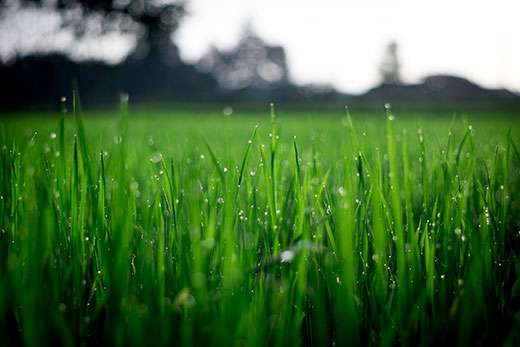
MANHATTAN – All grass seed is not created equal.
So says Kansas State University horticulture expert Ward Upham, noting that it’s nearly time to think about putting down seed to establish new turfgrass or boost spots that have gone bare in existing lawns.
“Choosing quality seed is one of the most important steps in successfully planting or overseeding your lawn,” Upham said. “If you don’t know what to look for, you may be introduced to unwanted intruders in that new stand.”
Of particular concern, he said, is seed contaminated with orchardgrass or rough bluegrass (known by its Latin name, Poa trivialis, or Por triv for short). “Those are both perennial grassy weeds that cannot be selectively controlled once they are in the lawn,” Upham said.
“Orchardgrass is a problem because it is faster growing and lighter green than our traditional turfgrasses in Kansas,” he said. “It is a bunch grass so it doesn’t spread, but infested areas are still unsightly due to small tufts of this species that pockmark the lawn.”
Rough bluegrass is fine-textured and forms circular patches in the lawn. Upham said it blends in fairly well with most Kansas lawns until summertime heat causes it to turn brown rapidly.
“If the rough bluegrass would just die in the heat,” he said, “it would only be a temporary problem. Unfortunately, it usually just goes dormant, turning green again with cooler temperatures and rain.”
Upham said avoiding those two nemeses begins with knowing how to decipher the label on seed packages. He suggests avoiding labels that read either ‘Other Crop Seed’ or ‘Other Crop.’
“That label refers to any species that is intentionally grown for some purpose,” Upham said. “That includes turfgrasses (not including the one you likely want) and pasture grasses. Orchardgrass and rough bluegrass both are listed as ‘Other Crop’ seed.”
By law, seed labels are required to show the percentage of ‘Other Crop Seed’ in a bag, but unless it contains 5% or more of the unwanted species, the label does not have to list those by name.
So, then, how much ‘Other Crop’ is too much?
“That’s a difficult question to answer, but the tolerance is very low,” Upham said. “It depends on what the other crop is and the buyer’s expectations for quality.
“In practice, ‘Other Crop’ may refer to something relatively harmless, like a small amount of perennial ryegrass in a bag of tall fescue, or it might refer to something bad like orchardgrass or rough bluegrass. The homeowner really has no easy way of knowing what the other crop is.”
If your expectations for quality are high, Upham advises buying seed that contains as close to zero ‘Other Crop’ as possible. Good quality seed will often have .01% or less, he said.
“Another line on the seed label is ‘Weed Seed,’” Upham said. “That should also be listed as .01% or less.”
Upham and his colleagues in K-State’s Department of Horticulture and Natural Resources produce a weekly Horticulture Newsletter with tips for maintaining gardens and home landscapes. The newsletter is available to view online or can be delivered by email each week.
Interested persons can also send their garden- and yard-related questions to Upham at [email protected], or contact your local K-State Research and Extension office.





